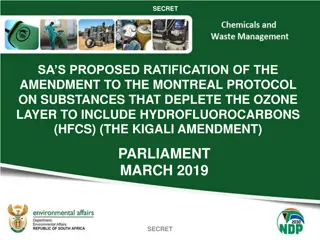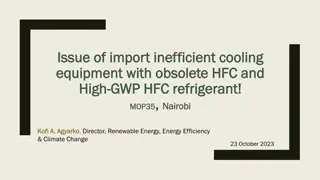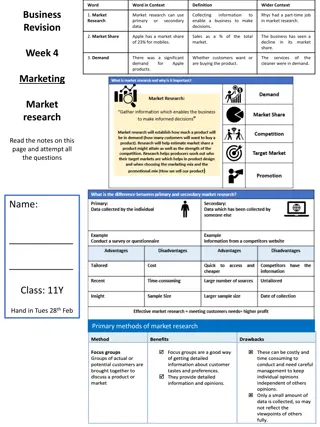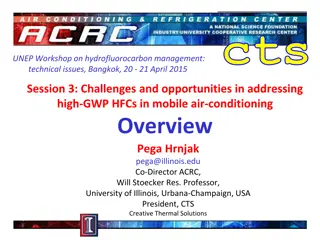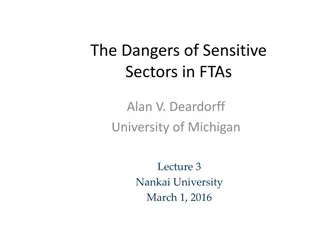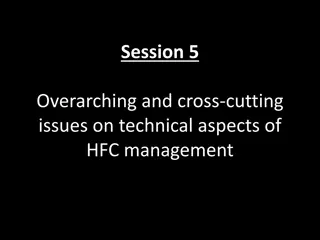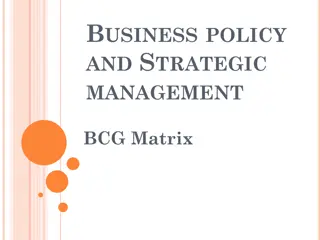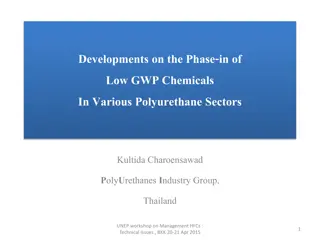Overview of HFC Market Sectors
The workshop by UNEP Ozone Secretariat in Bangkok delved into technical issues surrounding HFC management, with presentations on market sectors, emissions, demand dynamics, distribution of HFC chemicals, and mitigation strategies. Discussions centered on the current scenario, future possibilities, and challenges to overcome in reducing HFC consumption. The event emphasized the importance of addressing HFC emissions and demand for sustainability in various sectors.
Download Presentation

Please find below an Image/Link to download the presentation.
The content on the website is provided AS IS for your information and personal use only. It may not be sold, licensed, or shared on other websites without obtaining consent from the author.If you encounter any issues during the download, it is possible that the publisher has removed the file from their server.
You are allowed to download the files provided on this website for personal or commercial use, subject to the condition that they are used lawfully. All files are the property of their respective owners.
The content on the website is provided AS IS for your information and personal use only. It may not be sold, licensed, or shared on other websites without obtaining consent from the author.
E N D
Presentation Transcript
UNEP Ozone Secretariat Workshop on HFC management: technical issues Overview of HFC Market Sectors Presentation by Lambert Kuijpers, Ray Gluckman and Sukumar Devotta Bangkok, April 20th2015
Presentation Contents Introduction Lambert Kuijpers Details about Ray Gluckman use of HFC Chemicals HFC Markets Opportunities to reduce HFC consumption Sukumar Devotta Concluding comments
Emissions we have seen that HFC emissions can grow to high levels if BAU is extrapolated towards 2050 that means that there has been an enormous bank built up that cannot be adequately managed to better manage or to avoid
BAU demand we have seen that HFC demand can already increase enormously if BAU is extrapolated towards 2030 this is then fed into the bank which cause the emissions, dependent on sector and subsector to decrease by practices or / and by control
Distribution of HFC chemicals the TEAP TF XXV/5 report showed the distribution of high GWP chemicals over sectors and subsectors in the BAU demand extrapolation
Mitigation the TEAP TF XXV/5 report presented mitigation scenarios these show huge impact if low GWP options are applied in the main HFC markets in the period 2020-2030
Workshop on HFC management this workshop is directly related to what may occur with HFC demand and emissions in future it is at a crucial moment in time to discuss which direction sectors and subsectors can go for each market sector / sub-sector: what is possible now? what is possible in the near future? which hurdles and barriers need to be overcome?
Factsheets Factsheets developed for market sectors and subsectors describe current situation and on-going developments the Factsheets will be used as technical background for the sector and subsector sessions of utmost relevance to start with: a sound overview of which HFC chemicals are currently used? in which market sectors and subsectors are HFCs used? what is the relative importance of each sector?
Markets using HFCs (split by weight) 2012 RACHP: refrigeration, air-conditioning and heat pumps
The Importance of Sub-sectors: Refrigeration Small / medium distributed Large distributed Chillers Stand-alone Condensing Units Central systems Road vehicles Reefer containers Ships
The Importance of Sub-sectors: Stationary Air-conditioning Small self-contained Small / medium Small splits Large Large splits, multi-split VRF Ducted / packaged roof-top Domestic heating Domestic hot water Commercial / district heating
HFC use for topping up leaks in RACHP But average leak rates vary enormously in different sub-sectors: domestic refrigerators hardly leak at all split air-conditioning leak very little large supermarket systems leak significantly
Opportunities to reduce HFC consumption Four methods of reducing consumption of HFCs use of lower GWP alternatives in new equipment use of lower GWP alternatives in existing equipment leak prevention use of reclaimed HFCs
Lower GWP alternatives in new equipment key option to provide medium / long term savings various very low GWP options in some markets moderate GWP options may be needed
Use of lower GWP alternatives in existing equipment useful opportunity for short term savings mainly applies to larger R-404A systems e.g. in supermarkets / industrial systems R-404A has very high GWP 3922 exisiting systems can be retrofitted with much lower GWP alternatives with GWP in range 1400 to 2100 leads to >50% reduction in GWP-weighted demand sometimes saves 5% to 10% energy as well
Leak prevention historic levels of leakage are very high especially in sub-sectors such as supermarkets case studies in Europe show that leakage can be reduced by 50% quite easily important opportunity to reduce HFC consumption
Use of reclaimed HFCs important that end-of-life emissions are minimised HFCs must not be vented to atmosphere encouraging use of reclaimed HFCs reduces venting to atmosphere reduces demand for virgin HFCs
Concluding Comments key market for HFCs is refrigeration, air-conditioning and heat pumps 86% of total demand (GWP weighted) foams and aerosols also important markets various very low GWP and moderate GWP alternatives are available important issues to consider in each market sub-sector include: commercial availability energy efficiency cost safety performance in high ambient temperatures





